
Kuban Cossacks, or Kubanians, are Cossacks who live in the Kuban region of Russia. Most of the Kuban Cossacks are descendants of different major groups of Cossacks who were re-settled to the western Northern Caucasus in the late 18th century. The western part of the region was settled by the Black Sea Cossack Host who were originally the Zaporozhian Cossacks of Ukraine, from 1792. The eastern and southeastern part of the host was previously administered by the Khopyour and Kuban regiments of the Caucasus Line Cossack Host and Don Cossacks, who were re-settled from the Don from 1777.
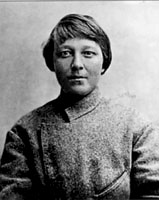
Maria Hryhorivna Nikiforova was a Ukrainian anarchist partisan leader that led the Black Guards during the Ukrainian War of Independence, becoming widely renowned as an atamansha. A self-described terrorist from the age of 16, she was imprisoned for her activities in Russia before managing to escape to western Europe. With the outbreak of World War I, she took up the defencist line and joined the French Foreign Legion on the Macedonian front before returning to Ukraine with the outbreak of the 1917 Revolution.

The Khotyn Uprising was a Ukrainian-led insurrection in the far-northern tip of Bessarabia region, nestled between Bukovina and Podolia. It occurred on January 7–February 1, 1919, less than a year after Bessarabia's annexation by the Romanian Kingdom. The city it was centered on is now known as Khotyn (Хотин), and is located in Chernivtsi Oblast, Ukraine; in 1919, it was the capital of Hotin County, on the unofficial border between Romania and the Ukrainian People's Republic (UNR). The revolt was carried out by armed locals, mainly Ukrainian peasants, assisted by Cossack deserters from the Ukrainian People's Army and groups of Moldovans, with some support from local Bolsheviks and White Russians. It forms part of the Ukrainian War of Independence, though whether or not the UNR covertly supported it, beyond formally reneging it, is a matter of dispute. The role of Bolsheviks, which has been traditionally highlighted in Romanian and Soviet historiography alike, is similarly debated. The Khotyn Uprising is therefore ambiguously linked to the Russian Civil War and the Ukrainian–Soviet War.
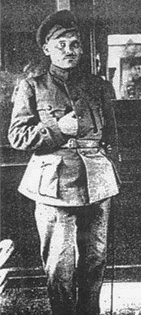
Nykyfor Oleksandrovych Hryhoriv was a Ukrainian military leader noted for repeatedly switching sides during the Ukrainian War of Independence and Soviet-Ukrainian war. He is today considered one of the most influential rebel leaders of the Otamanshchyna phenomenon.

The Southern Front was a military theatre of the Russian Civil War.

Operation Mińsk was a military offensive of the Polish Army during the Polish–Soviet War. It resulted in the capture of Minsk from the Red Army around 8 August 1919. The victory allowed the Polish troops to advance further into Russian-controlled Lithuania and Belarus and thus to present the Bolsheviks with a military fait accompli. The main Polish attack was toward Maladzyechna, Minsk, and Polotsk along the railroad lines. On 6 August, the Polish Army took over Slutsk and Minsk was taken two days later. The Polish units fought under command of General Stanisław Szeptycki. Polish control over the railway lines prevented the Russians from bringing in reinforcements. By the end of August, the Polish forces had taken Barysaw and Babruysk.
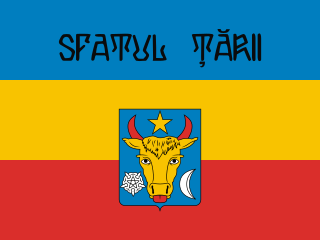
Sfatul Țării was a council of political, public, cultural, and professional organizations in the Governorate of Bessarabia in Tsarist Russia. This became a legislative body established the Moldavian Democratic Republic as part of the Russian Federative Republic in December 1917. and then union with Romania in April [O.S. March] 1918.

The Ukrainian People's Army, also known as the Ukrainian National Army (UNA) or by the derogatory term Petliurivtsi, was the army of the Ukrainian People's Republic (1917–1921). They were often quickly reorganized units of the former Imperial Russian Army or newly formed volunteer detachments that later joined the national armed forces. The army lacked a certain degree of uniformity, adequate leadership to keep discipline and morale. Unlike the Ukrainian Galician Army, the Ukrainian People's Army did not manage to evolve a solid organizational structure, and consisted mostly of volunteer units, not regulars.
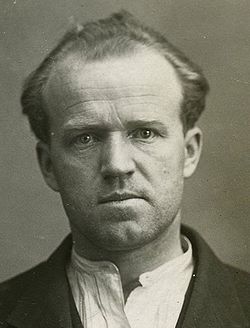
Yuriy (Yurko) Yosypovych Tyutyunnyk was a general of the Ukrainian People's Army of the Ukrainian People's Republic (UNR) during the Ukrainian–Soviet War.

The Red Cossacks was a military formation of Bolsheviks and the Soviet government of Ukraine. Red Cossacks was a collective name for one of the biggest cavalry formations of the Workers' and Peasants' Red Army (RKKA) and was part of the Ukrainian, Southern, and Southwestern fronts during the Russian Civil War and later was stationed in the Ukrainian SSR.

The Revolutionary Insurgent Army of Ukraine, also known as Makhnovtsi, named after their leader Nestor Makhno, was an anarchist army formed largely of Ukrainian peasants and workers during the Russian Civil War of 1917–1922. They protected the operation of "free soviets" and libertarian communes by the Makhnovshchina, an attempt to form a stateless anarcho-communist society from 1918 to 1921 during the Ukrainian War of Independence.
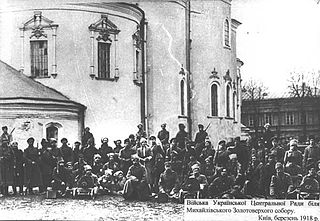
The Ukrainian–Soviet War is the term commonly used in post-Soviet Ukraine for the events taking place between 1917 and 1921, nowadays regarded essentially as a war between the Ukrainian People's Republic and the Bolsheviks. The war ensued soon after the October Revolution when Lenin dispatched Antonov's expeditionary group to Ukraine and Southern Russia.
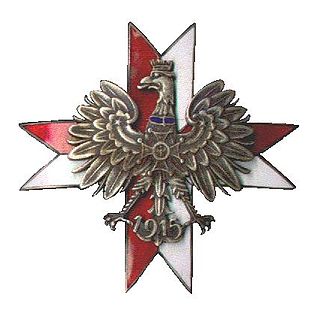
The First Krechowce Uhlan Regiment was a mounted unit of the Polish Army, active in the Second Polish Republic. Its traditions were continued during World War II, by a regiment of the same name, which was part of Polish Armed Forces in the West. 1st Krechowce Uhlan Regiment was formed in 1915, as a unit of the Imperial Russian Army. It fought in World War I, Polish–Soviet War and the Invasion of Poland, as part of Suwalska Cavalry Brigade. Until 1939, the regiment was stationed in Augustów. It ceased to exist in 1947. First commandant of the regiment was a Tsarist officer of Polish ethnicity, Colonel Bolesław Mościcki, who was killed in 1918 near Luninets. Last commandant was Colonel Leon Strzelecki.

Anatolie Popa was a Bessarabian-born military commander active during World War I and the Russian Revolution and Civil War, one of the organisers of the Moldavian armed resistance against the advancing Romanian troops in January 1918.
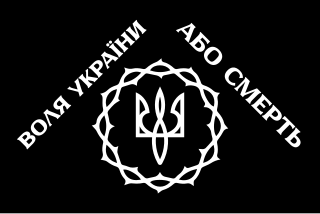
Kholodny Yar Republic was a self-proclaimed state formation, partisan movement, which ran on part of the lands of the former Ukrainian People's Republic, in the Chyhyryn district of the Kyiv province, in the area of the Kholodny Yar forest tract. The village of Melnyky was its capital. It had a 15,000-strong army composed of peasants and soldiers from the UNR army, which was defeated by the White Army in Podolia earlier.

The Romanian military intervention in Bessarabia took place between 19 January and 8 March 1918, as part of the broader Allied intervention in the Russian Civil War. It pitted the Kingdom of Romania, Russian Republic, Ukrainian People's Republic and anti-Bolshevik factions of the Moldavian Democratic Republic on one side, against the Bolshevik controlled Rumcherod and Odesa Soviet Republic, as well as pro-Bolshevik factions within the Moldavian DR. The intervention began when the Romanian army and its allies crossed into Bessarabia and launched an attack on Chișinău and Ungheni, capturing the latter.

Kostiantyn Yuriyovych Pestushko was a Ukrainian military leader, commander of the rebel Steppe Division, Otaman of the Kholodny Yar Republic.
The 3rd Cavalry Division was a military unit in the Workers' and Peasants' Red Army of the Armed Forces of the Union of Soviet Socialist Republics.
The Ukrainian Death Triangle refers to a historical situation of Ukrainian national forces in 1919, when the Ukrainian People's Army, or UPA, found itself in the general area south of Kyiv surrounded by Bolshevik, White Guard and Polish troops. In Ukrainian, this is also sometimes called the Quadrangle of Death or Rectangle of Death, in connection with the also hostile Kingdom of Romania.

















